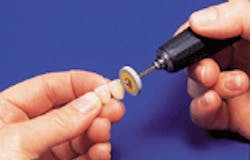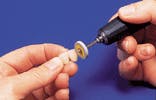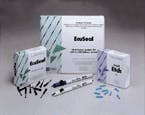Brasseler Polishing Products
Pearls For Your Practice
Joseph A. Blaes, DDS - Managing Editor
Pearl #1-Brasseler Polishing Products. Dialite, the tremendous porcelain polishing system, has been expanded to include many other shapes. When the system first came on the market a couple of years ago, the only shape available was a large-diameter wheel in the pre-polisher and the finisher. Over this period of time, Brasseler has added a number of shapes to the line, until now there is a complete family of shapes and sizes. This is the only product that I am aware of that will easily restore a natural, high shine to porcelain without having to reglaze. Now, all of your porcelain-polishing needs are met using one of these instruments. The white prepolishers are available in all shapes as well. Brasseler also has introduced a new composite polishing system called Diacomp (Figure 1). This is a two-step system that comes in three shapes-a point, a wheel and a cup. The secret is a unique, diamond-impregnated surface that comes in medium and super-fine grits. The system is not meant for gross reduction, but I have found that you can put on a great finish very quickly. The system eliminates the need for extra instruments and pastes to put on the final high polish that is so necessary with composites. Try the Diacomp system. I think it will surpass your expectations. To order, call Brasseler at (800) 841-4522.
Pearl #2-The EcuSeal System by Zenith Dental (Figure 2). Here`s another great DMG product being introduced into this country by the folks at Zenith. In case you are wondering, DMG is one of the largest dental research and development companies in Europe. EcuSeal is a new sealant. OK, OK, I know what you are thinking . . . "This is just what we need-a new sealant system." But read on. This one is different! The delivery process is unique, the autoclavable Ecu-pen features a rolling mechanism that is at the operator`s index finger to allow for easy, smooth and accurate placement of both the EcuSeal and the Etch Gel. This dispensing method is the key to the system. With it, you can easily control the flow and placement of the materials. EcuSeal is a light-cured, resin-based pit and fissure sealant, with a filler that releases fluoride and adds strength. Zinc has been added for its bacteriostatic qualities. It is packaged in a one-time-use, black Mikro-tip carpule that contains enough material to complete an entire quadrant of sealants. The blue Etch Gel is a 37 percent phosphoric acid packaged in a disposable, clear Mikro-tip carpule with enough for an entire quadrant. We (my hygienist and I) have used EcuSeal since October and have found the delivery system to make the application of a sealant quick and precise. I think you will like this system. It`s faster, better and easier! Order from your dealer or call Zenith for more information at (800) 662-6383.
Pearl #3-Minimal Invasive Dentistry. When I graduated from dental school, the so-called "air rotor" was just coming onto the market. Its introduction spelled doom for an air abrasion unit that was trying to replace the belt-driven handpieces. Dentists always have cut tooth structure with rotary instruments, and the air rotor allowed them to do just that much more efficiently than before. In the past few years, a number of companies have brought new air abrasion units on the market, and the concept of minimal invasive dentistry has been born. Simply stated, the proponents of air abrasion claim that less tooth structure is destroyed or compromised when used properly. Some of the advantages are:
- There is little or no pain associated with tooth preparation.
- There is no vibration or "chattering" while the tooth is being prepared.
- The high-pitched noise of the air rotor (which most patients dislike with a passion) is replaced with the sound of the vacuum equipment.
- The pediatric patient is especially well-suited for its use.
- It can be used on Class I, IV and V restorations.
- And, most importantly, the air abrasion unit can be used to check out those deep grooves and pits that look OK, but actually are decayed.
There are a number of disadvantages too, including the aluminum-oxide dust getting all over everything, a learning curve to develop proficiency and the cost of the units. But it certainly is a system that deserves a long look. Most of the manufacturers will allow you to try the units in your office before purchase. Find one that will leave the unit for at least 30 days. Do your homework and be sure the unit you choose is backed by a solid company that will be there if something goes wrong. This is exciting, new technology that may have a place in your practice. Take a look at the November 1996 issue of the Clinical Research Associates newsletter for a comparison of the units on the market.
Dr. Blaes practices in the St. Louis area and has developed every type of dental practice from solo to a 10-man group. He is known for his expertise in dental techniques and his innovative systems designs. He lectures, writes and conducts "in-house" seminars. He may be reached at (314) 843-3300.
Figure 1
Figure 2


